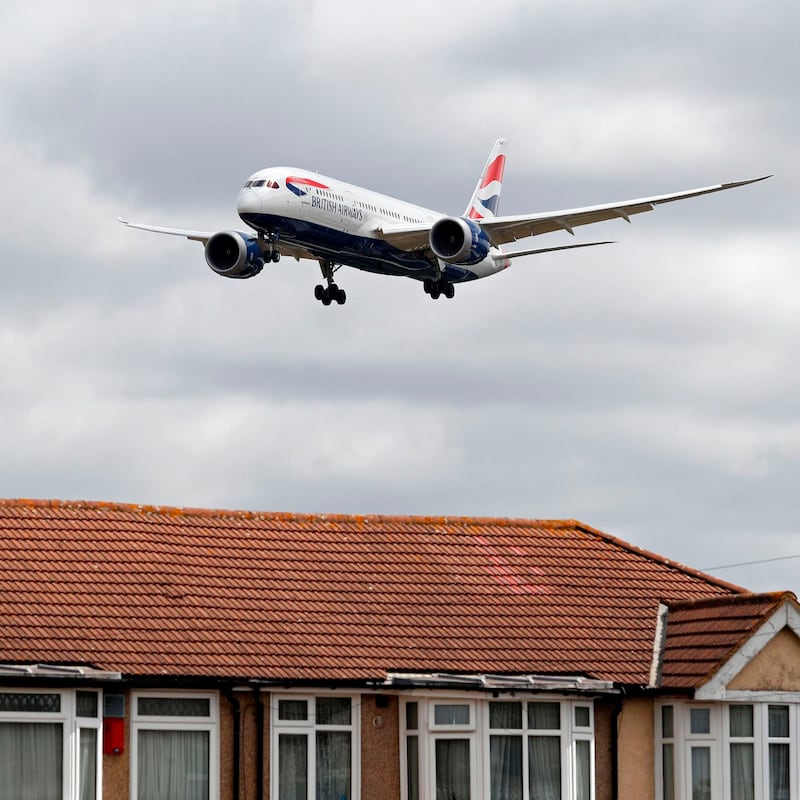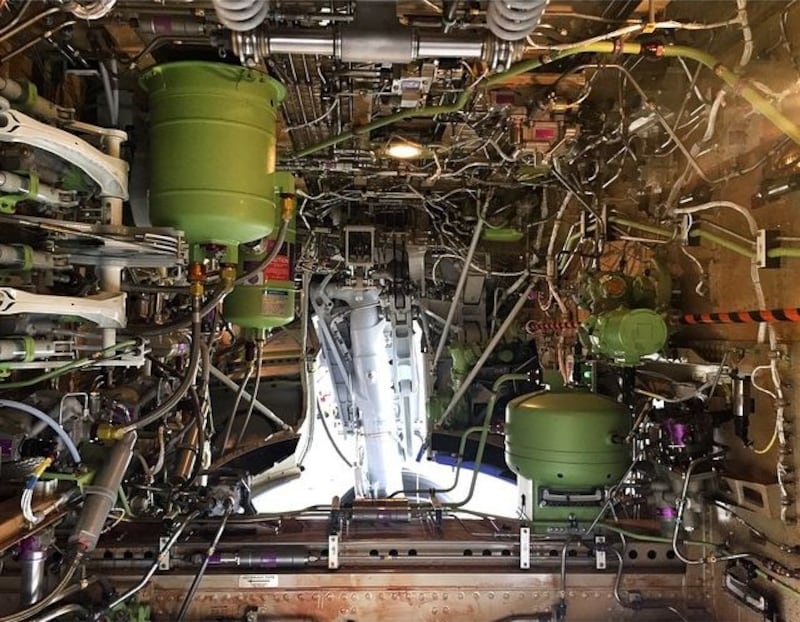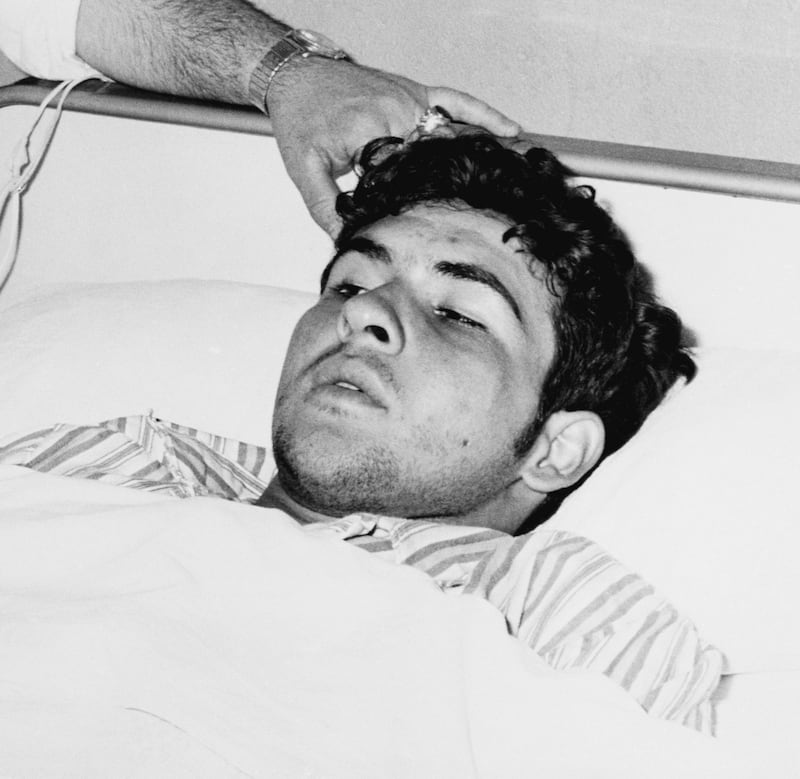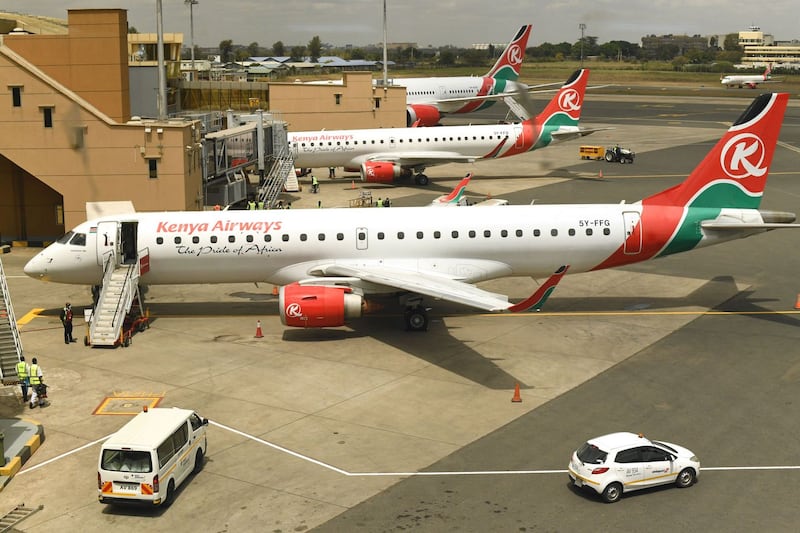It was Sunday, June 30th, 2019, a balmy summer’s afternoon, and Wil, a 31-year-old software engineer, was lounging on an inflatable airbed outside his house in Clapham, in southwest London. He was wearing pyjamas and drinking Polish beer. As he chatted to his housemate in the sunshine, planes on their way to Heathrow airport made their final approach overhead. On his phone, Wil showed his housemate an app that tells users the route and model of any passing plane. He tested the app on one plane, then held his phone up again, shielding his eyes from the sun and squinting into the sky.
Then he saw something falling. “At first I thought it was a bag,” he says. “But after a few seconds it turned into quite a large object, and it was falling fast.” Maybe a piece of machinery had fallen from the landing gear, he thought, or a suitcase from the cargo hold. But then he half-remembered an article he had read years before, about people stowing away on planes. He didn’t want to believe it, but, as the object got nearer and nearer, it became impossible to deny. “In the last second or two of it falling, I saw limbs,” says Wil. “I was convinced that it was a human body.”
As I went around the next road a police car came screaming past and very nearly clipped my handlebars. I thought, 'Oh my God. It was a human. That's definitely what this is'
Wil took a screenshot of the flight-app notification, and his housemate called the police to give them the details: Kenya Airways flight KQ 100, a Boeing 787-8 Dreamliner that had left Nairobi's Jomo Kenyatta International Airport eight hours and six minutes earlier, at 9.35am local time. Wil went out on his motorbike, hoping he would "see a bag lying on the road, praying it was just a bag or a coat or something," he says. At one point he found a rucksack lying in the road, and felt a surge of relief. On closer inspection, it was covered in dust. It couldn't have fallen from the plane.
"As I went around the next road," recalls Wil, "a police car came screaming past in the opposite direction and very nearly clipped my handlebars. I thought, 'Oh my God. It was a human. That's definitely what this is.'" Wil followed the police car, which led him to Offerton Road, 300m away from his home. A whey-faced young man – he looked to be in his 20s or early 30s – stood outside a handsome townhouse, trembling and silent. His name was John Baldock, also a software engineer, and originally from Devon, in southwest England. "He had a million-mile stare," says Wil.
Wil looked through the window, into the garden. The patio was “totally destroyed”. He looked at John. “The first thing I said to him was, ‘That was a human, wasn’t it?’ Because I still wasn’t 100 per cent. And he didn’t say anything, but he just looked at me and nodded. And then it hammered down on me, like a weight of bricks.”
Wil was right. It was a body. It – he – had plummeted a kilometre, half-frozen, hitting the ground at 3.38pm. He was the man who fell from the sky. The stowaway.
THE KENYA AIRWAYS STOWAWAY CASE would normally have been one for the Metropolitan police's missing-person's unit, but on the day the call came in, the team was swamped. So DS Paul Graves of the specialist crime unit volunteered. "I thought it was an interesting job," Graves told me when we met last year in his narrow, strip-lit office at Brixton police station.
In his three-decade career as a police officer, Graves had worked on stabbings, shootings, kidnappings and attempted murders. These were exacting cases, and he was well used to media scrutiny, family and friends demanding answers, and witnesses who were reluctant to co-operate. As an experienced senior detective, Graves hoped to identify the fallen man and repatriate his body, but he wasn’t exactly optimistic. “You’d struggle to find anyone who’s optimistic in the police,” he said with a chuckle.
When the call came in at 3.39pm, officers sped to Offerton Road, where they spoke to Wil, John and the neighbours. Police contacted Heathrow, which dispatched staff to examine the Kenya Airways plane’s wheel wells, the unpressurised area into which the plane’s landing gear retracts after takeoff. In the wheel wells there is just about enough space for a person to crouch and evade detection. Inside, staff found a grubby khaki rucksack with the initials MCA written on it.
The rucksack didn’t contain any significant clues: just some bread, a bottle of Fanta, a bottle of water and a pair of trainers. “It was literally about survival: food and water and a pair of shoes,” says Graves. But there was also a small amount of Kenyan currency, and the bottle of Fanta was found to have been sold by a Kenyan shop, indicating that the stowaway had almost certainly boarded the plane there. The flight had originally come from Johannesburg to Nairobi, Graves says, so it was helpful to rule out the possibility that the stowaway had smuggled himself on to the plane in South Africa.
Here was an anonymous man, travelling from a country where about a third of the population lives on less than $2 a day, who had fallen thousands of metres from the underbelly of a plane into one of the wealthiest postcodes in London
At Lambeth mortuary, pathologists took samples of the man’s DNA and copies of his fingerprints, and sent them to the authorities in Kenya. The DNA results came back quickly: no match. Graves was hopeful that he would have better luck with the fingerprints, as many jobs in Kenya require that candidates are fingerprinted. But the stowaway’s fingerprints weren’t on the Kenyan police database, either.
As Graves continued his work, reporters descended on Offerton Road, interviewing neighbours for a deluge of articles that were careful to mention the value of the house that John was renting (£2.3 million – €2.65m) and his alma mater (Oxford University).
It’s not hard to see why the story drew headlines. Stories of migrants risking their lives to reach Europe were familiar news fixtures. A month earlier, a record number of boats were intercepted in the English Channel on a single day, as more than 70 people were picked up by border forces. The previous year, the UN refugee agency estimated that six people died each day attempting to cross the Mediterranean.
But these stories had become so familiar that they were often met with apathy. The story of the Kenyan stowaway seemed novel. Here was an anonymous man, travelling from a country where about a third of the population lives on less than $2 a day, who had fallen thousands of metres from the underbelly of a plane into one of the wealthiest postcodes in London. “It’s in your face,” says Graves. “The meeting of worlds, at about 200mph.”

STOWING AWAY IN the wheel well of a passenger jet is, objectively speaking, a suicidally dangerous thing to do. According to the US Federal Aviation Administration, from 1947 to February 2020, 128 people around the world attempted to stow away in this manner. More than 75 per cent of them died. This is not surprising. At every stage, imminent death is all but assured. The stowaway may fall out of the plane as it is taking off, as happened to 14-year-old Keith Sapsford in February 1970, who fell from the wheel well of a Douglas DC-8 travelling from Sydney to Tokyo shortly after takeoff. (Astonishingly, a photographer captured the moment the schoolboy fell from the plane.) If the stowaway survives takeoff, they can be crushed by the landing gear as it retracts into the wheel well. This is how, in July 2011, a 23-year-old Cuban stowaway named Adonis Guerrero Barrios died above Havana after climbing on to an Airbus A340 bound for Madrid.
If the stowaway avoids being crushed, they will probably die shortly after. Within about 25 minutes of takeoff, most passenger planes reach a cruising altitude of 35,000ft feet – about 6.5 miles, or 10km, above sea level. The temperature outside the plane is approximately -54 degrees, although the hydraulic lines used to extend and retract the landing gear emit heat, raising the temperature by as much as 20 degrees. Still, -34 degrees is cold enough to induce fatal hypothermia. The air pressure at cruising altitude is only about a quarter what it is at sea level, which means that a person’s lungs cannot draw sufficient oxygen from the air. This will lead to hypoxia, when the blood is not able to supply enough oxygen to the tissues of the body, which can cause heart attacks and brain death. The rapid decrease in air pressure during ascent can also cause decompression sickness – known to divers as the bends – in which gas bubbles form in the body, causing a variety of debilitating conditions, some of them fatal.
If the stowaway somehow survives the journey, they will certainly be unconscious when the plane begins its descent. So when the plane's landing gear extends on its final approach, the stowaway will probably fall from the wheel well to the ground, many hundreds of metres below
If the stowaway somehow survives the journey, they will certainly be unconscious when the plane begins its descent. So when the plane's landing gear extends on its final approach, usually within about 8km of the runway, the stowaway will probably fall from the wheel well to the ground, many hundreds of metres below. This is why the bodies of stowaways are sometimes found in south London, under the Heathrow flight path. A Mozambican named Carlito Vale, who fell from a British Airways flight in June 2015, was decapitated on impact with the air-conditioning unit of an office block in Richmond. Pakistan-born Mohammed Ayaz fell from a British Airways flight in June 2001 and died on impact in a Homebase car park, also in Richmond.
And yet what is truly extraordinary, given the risks involved, is that some stowaways do survive. This is something scientists have trouble explaining, not least because they cannot run experiments simulating what happens to human beings shut into wheel wells at high altitude. “Something happens that we don’t fully understand,” says Paulo Alves of the Aerospace Medical Association. Their best guess about how some stowaways cheat death? They hibernate.
Stephen Veronneau, the world’s leading expert on wheel-well stowaways, outlined this theory in a 1996 paper for the Federal Aviation Administration. “The person’s core body temperature can fall to 27 degrees” – a healthy body temperature is between 36.1 degrees and 37.2 degrees – “or even lower. When the plane lands, a gradual rewarming occurs, along with reoxygenation. If the individual is so fortunate as to avoid brain damage or death from the hypoxia and hypothermia, cardiac arrest or failure on rewarming, or severe neurovascular decompression-sickness complications, some progressive recovery of consciousness occurs.” (Veronneau declined to be interviewed for this piece but confirmed via email that he still believes the hibernation theory holds true.)
To access the wheel well, you have to shimmy about 2m up the landing gear and crawl into the cavity that the wheels retract into after takeoff
Research on cold-water drowning cases seems to support Veronneau’s theory. In February 2011, 13 Danish teenagers and two teachers were on a boat that capsized in an icy fjord during a school trip. One of the teachers and some of the students were able to swim to shore and alert the authorities. (The other teacher was later found dead in the fjord.) By the time first responders arrived on the scene, 103 minutes later, seven of the teenagers were unconscious, floating in -2 degree water. In the two hours it took for them to be pulled from the fjord and flown to hospital, their hearts stopped beating. They had an average internal body temperature of 18.4 degrees. They were clinically dead, said Dr Michael C Jaeger Wanscher, who treated them.
At Copenhagen’s Rigshospitalet, doctors warmed the teenagers’ blood by 1 degree every 10 minutes, back up to 36 degrees, using an extracorporeal membrane oxygenation machine, which removes blood from the body, oxygenates it, and then pumps it back into the sedated person’s body. The process means the blood bypasses the heart and lungs, allowing them to heal.
After the teenagers were rewarmed, they were transferred to the intensive-care unit, where they remained deeply sedated, on ventilators, before being gradually weaned off the machines. All seven regained consciousness. One student experienced severe physical and cognitive damage, and now lives in a residential facility. The other six experienced mild to moderate brain damage but were able to lead relatively normal lives, eventually returning to school. “They have studied and passed exams, but perhaps at a lower level,” Wanscher tells me. “They are not precisely like they were before the accident. There is a difference. They also feel it in themselves. They will say: ‘I don’t function like I used to before.’”
When a person is near-frozen, their oxygen and energy needs diminish, making them less susceptible to hypoxia-induced brain damage. When the person is gradually rewarmed, they reawaken, as if from a dream. "We've learned beyond any shadow of doubt that this is possible," says Alves. "There is tangible evidence. Some of the stowaway survivors are covered in frost, showing that they truly underwent hypothermia."
To be frozen and come back to life. It is fantastical. And yet it seems to be true.
IN SEPTEMBER 2019, three months after Graves took on the case, he flew to Kenya, hoping to uncover any scrap of information that might help identify the stowaway. He visited slums around the airport. He visited mortuaries, which were full of unclaimed bodies. Officials took him on a tour of Nairobi airport and gave him access to CCTV recordings. They revealed that after the plane landed from South Africa, it was taken to stand 1, where it sat for five hours, before being moved to departure gate 17, where passengers boarded the flight to London. CCTV of the departure gate and runway shows that nobody jumped on the plane as it was taking off and nobody climbed into the undercarriage while it was at gate 17. That means the stowaway almost certainly boarded the plane when it was being held at outer stand 1, where the CCTV coverage was less clear.
How had the stowaway managed to get on the plane? From a physical perspective, this wouldn’t have been hard. Stowaways usually make for the two rear wheel wells, because they are bigger than at the front of the plane. To access the wheel well, you have to shimmy about 2m up the landing gear – it is covered in struts, making it easy to get a foothold – and crawl into the cavity that the wheels retract into after takeoff.
The hard part would have been gaining access to the aircraft before takeoff. Security at Jomo Kenyatta International was tight. “There was no evidence of any obvious security breaches,” says Graves. “All the staff had to use passes to go through secure gates.”
Graves knew that a groundworker, baggage handler or cleaner would have access to the plane when it was being cleaned, refuelled and loaded for takeoff. "You're looking for a low-paid, low-educated person with access to the pan," says David Learmont, consulting editor at the aviation-news website FlightGlobal. (The "pan" is a military term for the parking area when an aircraft is on the ground.) "It would be unlikely to be someone like a mechanic, because they'd know that stowing away is not a good way to get a cheap flight, because they wouldn't get to enjoy the other end."
When Graves flew to Kenya, there was a moment after takeoff when the detective heard the crunch of the wheels retracting. He turned to his colleague and winced. 'We just looked at each other,' he says
But Kenyan airport authorities insisted to Graves that all their employees were present and accounted for, and that police interviews had found no evidence that staff had assisted the stowaway in accessing the aircraft.
Another possibility was that the stowaway had reached the plane by breaching the outer perimeter of the airfield. In 2014, a 15-year-old stowaway named Yahya Abdi climbed over a fence at San Jose airport, in California, and stowed away on a flight to Hawaii. (Abdi survived the flight.) But, again, airport officials assured Graves that the perimeter had also been secure. As with all of these claims, he had little choice but to take their word for it. (Jomo Kenyatta airport did not respond to multiple requests for comment for this article.)
The case was befuddling. A man had climbed on to the plane in Nairobi. He had fallen from the sky over London. He was Kenyan. All these things were certain or very nearly so, yet Graves was no closer to finding his man.
Graves is not the type to be maudlin, but the case did affect him. On the flight to Kenya, there was a moment after takeoff when he heard the crunch of the wheels retracting. He turned to his colleague and winced. “We just looked at each other,” he says. It was awful to imagine a person sitting beneath them, alone, cowering in the wheel well. “In my job you see lots of horrible things – dead bodies and smashed-up people – and you do suffer compassion fatigue, to a degree. But when I heard the noise of the wheels I thought, Oh blimey. It felt like such a desperate thing to do.”
For Graves, the story was always bigger than how the stowaway made it on to the plane. The question was: why? “We saw the aftermath of someone falling from an aeroplane,” says Graves. “But for me, the interesting part was, where did the story start?”

SINCE THE EARLIEST DAYS of aviation, there have been stowaways. People from countries including Cuba, South Africa, Kenya, Nigeria, Senegal, the Dominican Republic and China have secretly climbed on to planes in the hope of leaving their old lives behind. They abscond for all kinds of reasons: poverty, unhappiness, boredom, despair. Bas Wie, the 12-year-old who stowed away in a Douglas DC-3 from Indonesia to Australia in 1946, was an orphan who worked for food in the kitchens of Kupang airport in West Timor. Abdi, the teenager who flew in the wheel well of a Boeing 767 from California to Hawaii, said he was trying to get back to his mother, in Somalia.
Every known wheel-well stowaway has been male, although a Cuban woman did ship herself to the United States in the pressurised hold of a cargo plane from the Bahamas in 2014. The youngest documented case involved a boy of nine, although the majority of stowaways are adults under 30. Very few stowaway cases involve domestic flights.
Cuba is the most common country of origin for wheel-well stowaways, with nine cases since 1947. Armando Socarras Ramirez was the first. In June 1969, when he was 17, Ramirez hid in the right wheel well of a Douglas DC-8 that was due to make the eight-hour flight from Havana to Madrid. Upon landing, the pilot found Ramirez lying under the plane, covered in ice, not breathing. "The doctors in Spain called me the Popsicle!" Ramirez told me recently. He is now 69, a father of four and grandfather of 12, and lives in Virginia.
From the age of 10, Ramirez had wanted to leave Cuba. He got the idea to stow away from his friend Jorge Pérez Blanco, who was a year younger than him. Together, they staked out Havana airport. “The only airline suitable was Iberia,” Ramirez said, “because the rest were going to communist countries. If we’d landed there they’d have sent us right back – maybe in the same wheel well!” The Iberia Airlines flight from Madrid landed on a Tuesday morning, refuelled, and departed on Tuesday evening.
When the plane got up in the air the compartment started opening up to let the wheels come inside. I was hanging on with my fingertips to the edge of the compartment and being blown sideways by the wind
On June 3rd, 1969, Ramirez and Pérez waited outside the perimeter fence. Ramirez carried a rope, a torch and cotton wool to stuff into his ears. As the plane began to taxi towards the runway, they jumped the fence. Pérez started to have second thoughts, and Ramirez half-dragged him to the plane. The engines were roaring madly. They approached from the rear.
Pérez entered the left wheel well, and Ramirez the right. The plane took off. “When the plane got up in the air,” he says, “the compartment started opening up to let the wheels come inside. I was hanging on with my fingertips to the edge of the compartment and being blown sideways by the wind.” His middle finger later turned black from frostbite and exertion. (Pérez fell out of the plane and was found alive on the runway in Havana; he was later imprisoned by the Cuban government.)
As the wheels came up, Ramirez got a foothold, which stopped him from falling out of the plane, but now he faced a new problem: the landing gear was crushing him. He begins to hyperventilate at the memory, and had to stop for a minute to compose himself. “It was crushing me and I was pushing out and the wheel was pushing in,” he continues. Luckily, the wheels popped out again, Ramirez says, giving him time to readjust his position before the compartment shut tight.
Inside the wheel well, it was black and deafening. “You became part of the noise. It made me shake. I put some cotton wool in my ears, but it didn’t work. When you become the noise, it’s beyond comprehension,” he says. But, wedged into the corner of the compartment, he felt overjoyed. “I was content,” he says, “because I made it.”
I saw people around me and the room was moving around, like I was dizzy. Everything was moving, the walls were moving, and the lights were moving from side to side
He leaned against the tyres, which were hot to the touch, but cooled down quickly as the temperature in the wheel well plunged. “It was very, very freezing,” he says, “and I was shivering and shaking.” He passed out, and his next memory is of waking up underneath the plane in Madrid, before he blacked out again. Paramedics were called. Staff carried him into the airport and left him on the ground, thinking he was dead. Then he came to again. “I saw people around me and the room was moving around, like I was dizzy,” he says. “Everything was moving, the walls were moving, and the lights were moving from side to side.”
Ramirez spent the next 52 days recovering in hospital. He was an international media sensation, visited by reporters from the New York Times and Reader’s Digest. Back in Cuba, the authorities were angry. “Castro talked to my father,” claims Ramirez. “He said: ‘I don’t have any issues with you guys. The one I want to get my hands on is your son.’ Because I embarrassed them!”
At first he was unable to hear anything, and staff had to communicate with him using a chalkboard, but after a month his hearing returned. Incredibly, he says he has suffered no long-term health consequences. “My blood pressure is normal, my heartbeat is normal,” he says. He worked as a firefighter for 11 years.
A devout Christian, Ramirez believes divine intervention saved his life. “God put his hand on me,” he says. He has only one regret. “After me, in Cuba, a lot of youngsters tried to do what I did,” he says, “and most of them died.”

WHEN GRAVES HAD EXHAUSTED all his leads in Kenya, there was only one thing left to do: make his findings available to the media, in the hope of reviving coverage of the story and triggering someone's memory. "People probably think that the police go out there and search for clues," he says. "But what we rely on really is the public, and witnesses seeing things and telling us."
But the idea of more media attention did not go down well with his counterparts in Kenya, Graves says. It is not hard to see why. For the people who run airports, stowaways are embarrassing, dangerous and often expensive. After San Jose’s perimeter was breached, the airport spent more than $15 million, or almost €13 million, upgrading more than 3km of fencing. And for governments these incidents are bad news, prompting people around the world to wonder why their citizens might be so desperate to leave the country that they would take such extraordinary risks.
In July 2013 a 32-year-old Turkish man named Hikmet Komur died after stowing away in the wheel well of a British Airways flight from Istanbul to London. In the days after the incident Komur's family were visited by Turkish police and told not to push for more information on how he had accessed the plane. "They told my other uncle not to drag out the situation," Komur's niece Fatos, a student from London, told me. "They said to drop it."
For Kenyan authorities, there may have been an additional concern. In 2017, Jomo Kenyatta International Airport received a category 1 security classification, permitting direct flights to the United States. “There is a general feeling among police that, if the stowaway was shown to be someone who originated from Kenya, the airport security rating would be dropped,” says Hillary Orinde, a Kenyan journalist who works for Agence France-Presse. “Every police officer I’ve spoken to has been cagey, for that reason.”
I expected because they had been told their family member was dead that there would be a sombre mood, but when I went there it was just a normal day. Money had changed hands, and an illiterate father was convinced to go on record and say that his son was the stowaway
Graves did manage to persuade Kenyan police to circulate information about the case through their police gazette, hoping to encourage regional officers to make inquiries. On his return to the UK in October, he disseminated an efit of the stowaway’s face – which had been reconstructed by pathologists in the days after the incident – alongside a photograph of his meagre possessions. The accompanying press release made reference to the initials written on the stowaway’s rucksack: MCA.
Reporters seized on this new information, and on November 12th Sky news published the results of an investigation in which it claimed to have identified the stowaway as Paul Manyasi, who had been 29 and worked as a cleaner at the airport. Manyasi's girlfriend, who was given the pseudonym Irene, told Sky that the initials on the rucksack stood for "member of county assembly", claiming this was Manyasi's nickname. His mother claimed to recognise his underpants.
Willy Lusige, a journalist for the Kenyan TV network KTN News, was stunned. Like many Kenyan journalists, he had followed the story closely and attempted to identify the stowaway himself, but he got nowhere with the airport authorities or police. He had trouble believing the case had truly been solved. Orinde also had misgivings. “His mother said she hadn’t spoken to him for a number of years,” Orinde says, “but she was able to identify his underpants?”
Both men began to dig into the Sky investigation. When Lusige found the family of the man Sky had identified as Paul Manyasi, he knew that something was wrong. “I expected because they had been told their family member was dead that there would be a sombre mood,” he says, “but when I went there it was just a normal day.” The father told Lusige that some white people came to visit the family and gave them $200. “Money had changed hands, and an illiterate father was convinced to go on record and say that his son was the stowaway,” says Lusige.
When foreign journalists come and do a story in Kenya, people open up, because they think that people around them will not see the story. They don't imagine anyone at home is going to check to see if what was reported was true
The Sky investigation quickly disintegrated. There was no record of a Paul Manyasi ever having worked at Jomo Kenyatta airport. Nor did the parents who Sky had spoken to have a son named Paul Manyasi. Their son was called Cedric Shivonje Isaac. (It is unclear where the name Paul Manyasi came from.) Finally, there was the inconvenient, but not inconsiderable, fact that Isaac was not dead but alive, locked up in prison in Nairobi.
“When foreign journalists come and do a story in Kenya,” Orinde says, “people open up, because they think that people around them will not see the story. They don’t imagine anyone at home is going to check to see if what was reported was true.” On November 22nd Sky retracted the article and published an apology.
Orinde remains perplexed by the case. “Kenya doesn’t have such a culture of people desperately trying to get to the west by any means possible,” he says. Kenya is relatively wealthy compared with many other countries in the region, with the sixth-largest economy in Africa. A more pressing concern, says Orinde, are the migrant workers who go to the Gulf states, and end up being abused by their employers.
By the end of 2019, Kenyan officials had wrapped up their investigation, and no breach had been found at Jomo Kenyatta International Airport. It retained its category 1 security status. Then, more than a year later, something strange happened. On February 4th, 2021, a Turkish Airlines Airbus A330 freighter landed at Maastricht. Above the main landing gear was a 16-year-old Kenyan boy. The plane had originated from Jomo Kenyatta airport on February 3rd, making stops in Istanbul and London before landing in the Netherlands. Miraculously, the boy was alive, and apparently unharmed. He was discharged from hospital after a day.
In a statement, the teenager told Dutch investigators that he walked on to the plane and fell asleep, and explained that his motive for leaving Kenya was to seek a better life. He is now seeking asylum in the Netherlands. Jomo Kenyatta airport authorities have not acknowledged the incident, or explained how a stowaway was able to breach their security protocols once again. Flights from the airport continue to land in the UK.

WE STILL DO NOT KNOW the identity of the man who fell to earth on June 30th, 2019. All we know – or think we know – are the last things he would have seen and heard. The grunt and hiss of hydraulics inside the wheel well as flight KQ 100 waited on the runway in Nairobi. The clattering footsteps on metal stairs as passengers boarded the plane. The thud of suitcases being thrown into the hold. The plane pulling away from the stand, pivoting and taxiing towards the runway. White markings flashing beneath his feet. A pause, and then the drone of Rolls-Royce engines attacking asphalt at 290kmh. The plane picking up speed, the noise intensifying into the pneumatic whine of a thousand dentist's drills. Lift-off. A whip of wind, an icy chill, and up to 3km, 5km, 10km – the full 35,000ft. Colder and colder. Unconsciousness. Oblivion.
He was buried in Lambeth cemetery on February 26th, 2020. It was a beautiful morning, crisp and clear, and freezing cold. I hopped from foot to foot to stay warm, my fingers trembling as I fastened the buttons on my coat. Around me, four workers from Lambeth council, in green coveralls and mud-clogged boots, waited to see if any mourners would arrive. Beside them a man waited with a digger, ready to fill in the earth.
The council workers talked among themselves about the stowaway's death. "Considering he fell quite far," one remarked, "he was in reasonably good condition."
"A poor person was sunbathing, weren't they?" said the gravedigger. "Thump!"
I looked at the grave. A nameless man lay before me in an unmarked grave, identifiable only by a simple wooden cross and a numeric code. There are so many people like him
By now I was shaking from the cold. As they prepared to lower the body into the ground, a solitary mourner panted into view – an official from the Kenyan embassy, dressed in a black suit and leather shoes, barely making it in time. He had the harried air of a man with many obligations and better things to be getting on with. We nodded at each other, and then the workmen stepped forward. The mood switched from cheerful banter to sombre efficiency. They lowered the coffin into the ground, and inclined their heads for a few seconds. On the coffin was a metal plaque, reading: “Unknown (Male), Died 30th June 2019, Aged 30.”
The horror of the death of the Kenya Airways stowaway made for newspaper headlines, but many more migrants die, in equally horrific circumstances, every week. They are locked in the back of lorries and asphyxiate, or fall from moving freight trains, or drown in the Channel. They are shot by border-patrol guards through chain-link fences, or electrocuted in the Channel tunnel, or beaten to death by racist mobs. They are held in detention centres for years, where they are subject to physical and sexual abuse. Sometimes they burn themselves alive, out of despair. Since 2014, 10,134 people have died on global migration routes, according to the Missing Migrants project. These figures are likely only a tiny fraction of the true picture.
When the body was in the ground, the embassy worker spun on his heels and hurried away. I looked at the grave. A nameless man lay before me in a little plot of southwest London, in an unmarked grave, identifiable only by a simple wooden cross and a numeric code. There are so many people like him. They keep quiet counsel in unvisited graves, and their stories vanish with them. – Guardian














